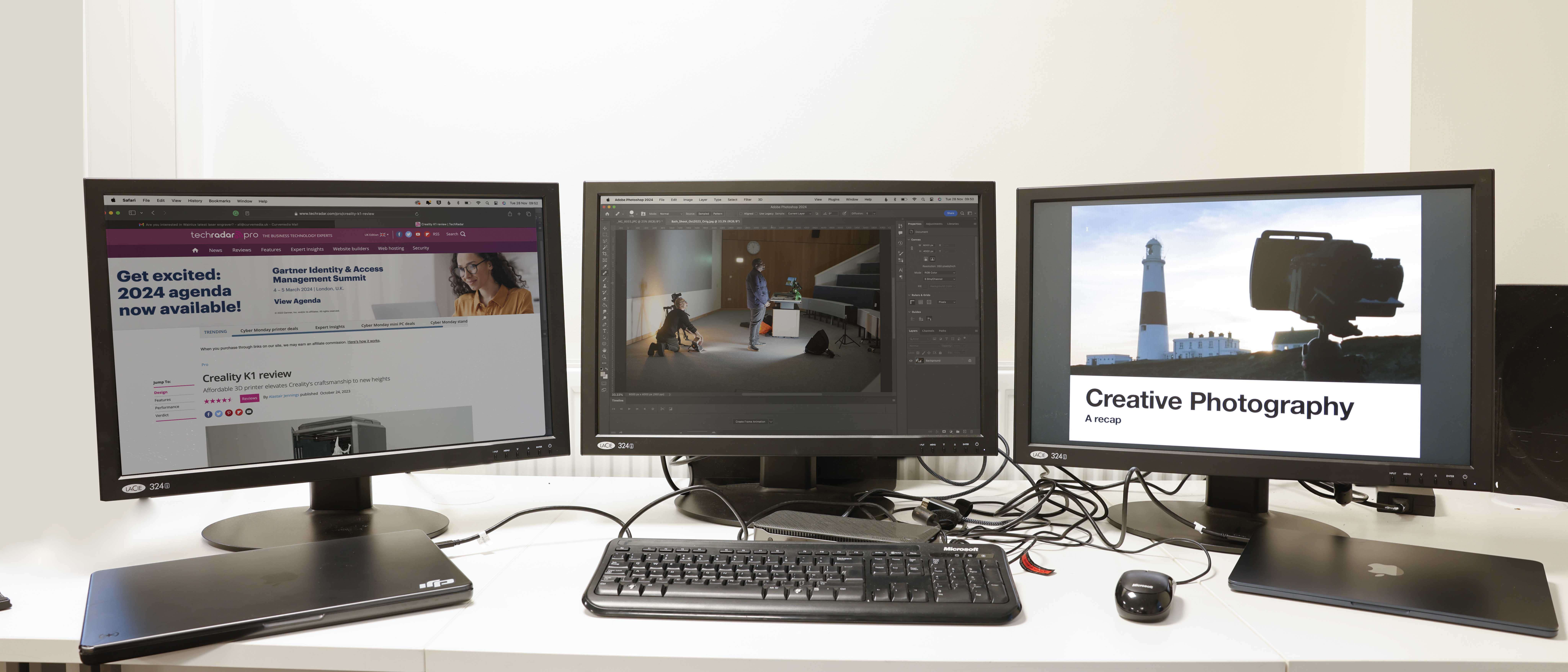TechRadar Verdict
The Targus Dual Host USB-C KVM 4K is essentially an all-in-one desktop hub that enables you to plug two computers into a range of accessories, such as a keyboard, mouse, and monitors. It also features a dual 100W PD Charge, meaning that you can charge up your laptops while at your desk without digging around for chargers. The solution is extremely neat, with all modern connectors enabling ultra-easy connection and use, including a direct hard wire link to your network. As an effective docking station, there's little here not to like.
Pros
- +
All-in-one docking station
- +
KVM switch between two machines
- +
Plenty of connection options
Cons
- -
Network storage is required
- -
Slightly plastic build quality
Why you can trust TechRadar
Targus Dual Host USB-C KVM 4K: 30-second review
The best KVM switches are vital for anyone using more than one machine, particularly if you use both a desktop and a laptop on a daily basis. The basic premise is that, like a hub, you have all the necessary ports and connections for a quick setup as soon as you're back in the office. Moreover, these devices take it a step further by allowing you to switch from one machine to another.
The Targus Dual Host USB-C KVM 4K is an exemplary advanced KVM docking station, offering a plethora of connection options that support up to two machines and three displays. Its function and usability are straightforward, with plug-and-play functionality enabling quick setup.
Unlike some lightweight KVMs that are bus-powered, the Targus Dual Host USB-C KVM 4K utilizes an AC power supply. This design includes two 100W PD power USB Type-C ports, ample for charging two MacBook Pros and an ideal solution for any office.
What sets this KVM apart is its level of control. Plug in two computers and three monitors, and you can split the display across them – all three monitors for one machine or a combination thereof. This is ideal, then, when paired with any of the best monitors for a dual-set-up (and then some). This flexibility is enhanced further by allowing the use of a single keyboard and mouse across both machines, eliminating the need to switch inputs.
The Targus Dual Host USB-C KVM 4K is streamlined and intelligent, enhancing the functionality and utility of an office essential.
Targus Dual Host USB-C KVM 4K: Price and availability
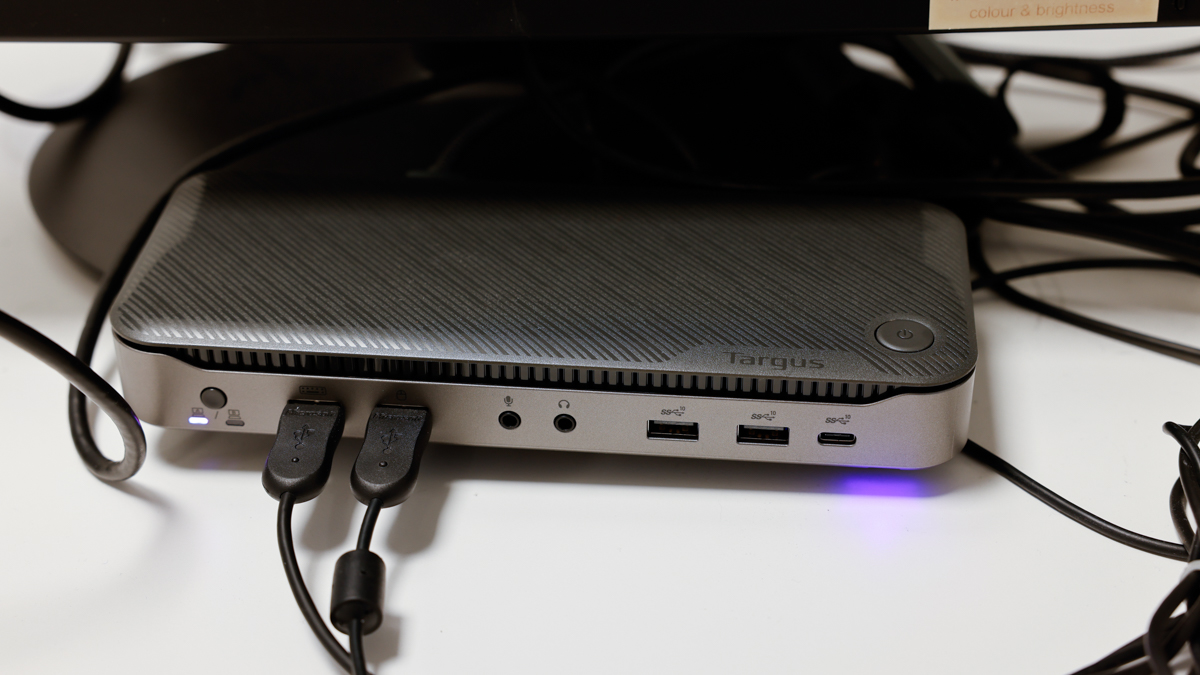
- How much does it cost? Starting from $499
- When is it out? Available now
- Where can you get it? You can get it directly from https://us.targus.com or other online resellers.
The Targus Dual Host USB-C KVM 4K is on sale now. Although the price might seem expensive at a touch under $500, considering the Apple 96W charger is $79, and this essentially offers two units along with a KVM and multi-port hub, it's excellent value for money.
- Value: 4 / 5
Targus Dual Host USB-C KVM 4K: Specifications
Model: | Targus Dual Host USB-C KVM 4K |
Connection Technology: | Hybrid (Universal & DP Alt Mode) |
Host Port Compatibility: | USB-C |
Compatibility: | Works with Windows, macOS |
Maximum Host Power | 100W (Dual) |
Output Voltages: | 5V, 9V, 12V, 15V, 20V |
Display Ports: | HDMI: 1, DisplayPort: 2, |
USB Ports: | Total USB-A Ports: 3, USB-C Ports / 3.2 Gen 2: 1 |
Dimensions: | 22.38 x 8.89 x 3.33 cm (8.81 x 3.5 x 1.31 inches) |
PSU: | Not specified |
Dimensions: | 34 x 23 x 2.5cm |
Weight: | 0.44kg (0.96 lbs). |
Targus Dual Host USB-C KVM 4K: Design
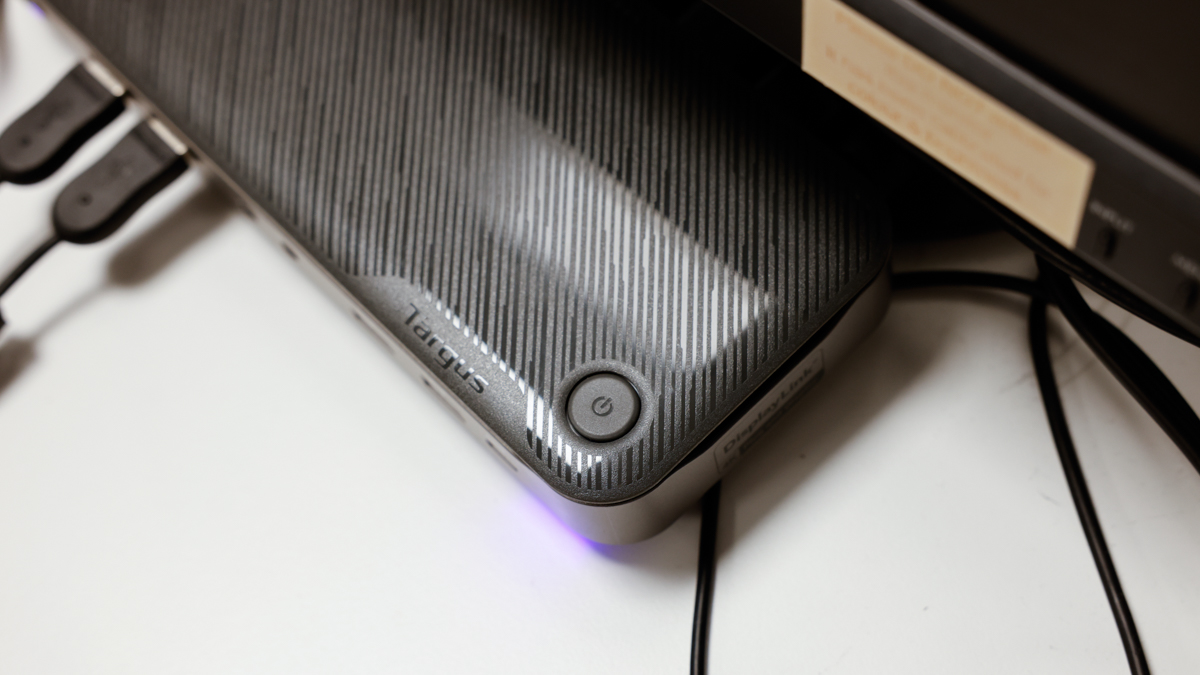
- Dual 100W charging
- Practical Long-Bar Style
- Secure Locking Connections
The overall design of the Targus Dual Host USB-C KVM 4K is decidedly desktop, adopting the all-too-familiar long bar style common in switchers and hubs. This design is practical as it sits neatly on a monitor stand, allowing quick and easy access to the ports for both monitors and computers.
Sign up to the TechRadar Pro newsletter to get all the top news, opinion, features and guidance your business needs to succeed!
At the back of the unit is the main power socket, connecting to a standard AC power adapter and wall socket. There are also two USB Type-C ports for the machines, each offering a full 100W of power simultaneously, which is a notable feature.
Another feature of these ports is that the supplied USB cables have locking screw threads, similar to traditional cables, allowing them to be screwed into and locked into the back of the KVM. This design prevents accidental disconnections. The supplied cables are high-quality examples that support both power delivery and data transfer.

Next to the two USB Type-C ports are an HDMI and two DisplayPorts, supporting up to three 4K displays, followed by a Gigabit Ethernet port.
On the side is a T-Bar lock slot for security, with a power button on top that illuminates a purple LED when on. On the front right, there's a USB Type-C and two USB Type-A ports, then 3.5mm audio in and out, and two more Type-A ports. These two ports are labeled for the keyboard and mouse and should be used for this purpose as they enable auto-switching. Beside these is the switch that allows you to cycle through monitor configuration modes.
Functionality-wise, it's all there: a standard design but well laid out. Regarding build quality, two rubber pads on the base prevent slipping off the monitor stand, and the top has a textured finish for an ergonomic look of quality. The plastic itself feels and looks a bit cheap but is balanced by the metal-effect base.
- Design: 4 / 5

Targus Dual Host USB-C KVM 4K: Performance
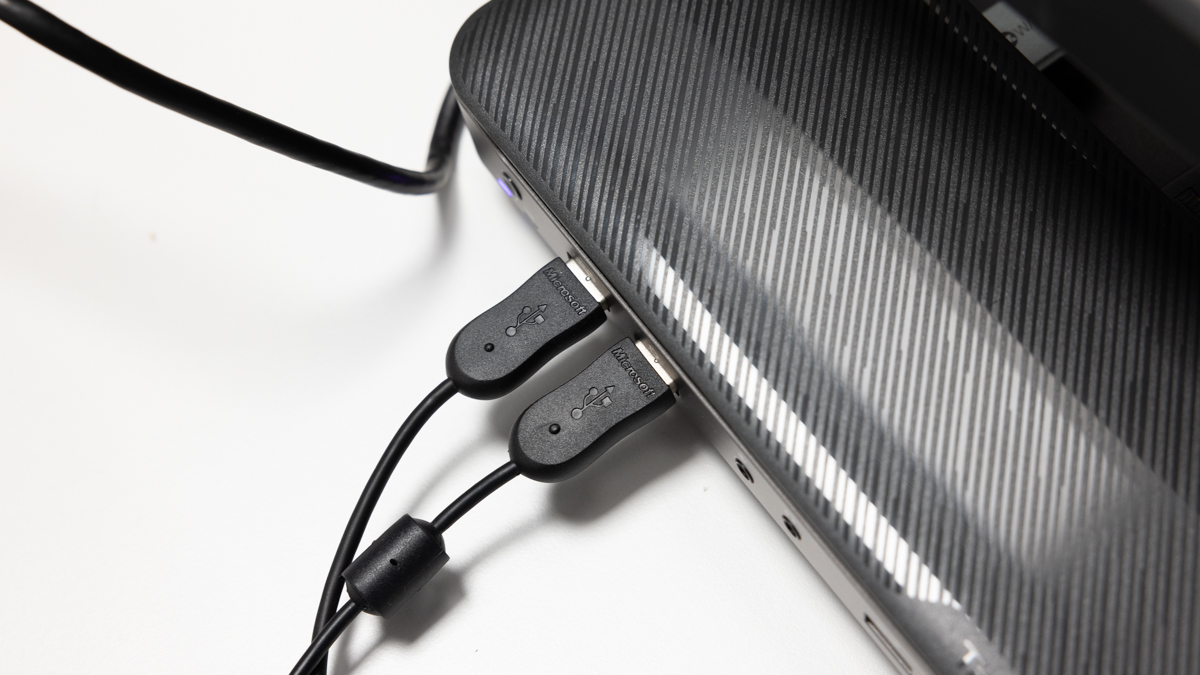
- Multi-Device Switching
- Quick Setup Process
- Simple, Intuitive Control
Even with the wire reduction that a decent KVM or hub enables, there's no getting around the fact that a little cable management is initially needed when setting up and placing the Targus Dual Host USB-C KVM 4K.
The slim block design, with two rubber pads on the base, holds the unit nicely on the base of the BenQ monitor. Due to space, I usually use a dual 27-inch monitor setup, but to test the full capability of the KVM, I've added a smaller Dell monitor into the mix. The two BenQ monitors are connected through DisplayPort, while the smaller monitor uses the HDMI socket.
With the monitors connected, there's little to report; all is easy, and with a bit of cable tidying, it all looks good. The next step is connecting the two computers, in this case, a MacBook Pro M1 16-inch and MacBook Air M2, both using the two USB Type-C ports on the back of the KVM. Instantly, the power symbol illuminates to show that everything is working and power is being delivered to the laptops.
Next, the keyboard and mouse are connected to the icon-labeled ports on the front of the KVM. With the three displays currently showing the output from the first laptop, the keyboard prompt has appeared, and I can click through the setup process in the usual way.
Then, a single press of the switch button on the front of the KVM switches to the screen of the second laptop. I can confirm the selection of the keyboard and mouse on the first screen while the second and third screens still display from the first monitor. Then, I can drag the mouse from the first monitor and machine to the second and then to the third.
The machine to which the mouse and keyboard are attached automatically switches with the movement of the mouse. The switch is quick but noticeable. However, the move from the second to the third monitor, both displaying from the same machine, is swift.
With another click of the KVM switch, the first two monitors show the display from the second machine, while the last shows the first machine. Click again, and all monitors show the second computer's display – it's all very quick and smooth. The only issue is that the button works on a carousel rotation, so you need to cycle through the modes to reach the desired one.
Likewise, if you want to use an Ethernet connection or have a NAS, this can be attached to the Ethernet port on the back. However, you can't connect a hard drive and switch from the machine it's mounted on to the other without the hard drive disconnecting. It would be handy if there were a way to either enable a single drive to stay connected to a single machine or, ideally, be networked across both machines.
Still, what this KVM enables does make things extremely simple and quick.
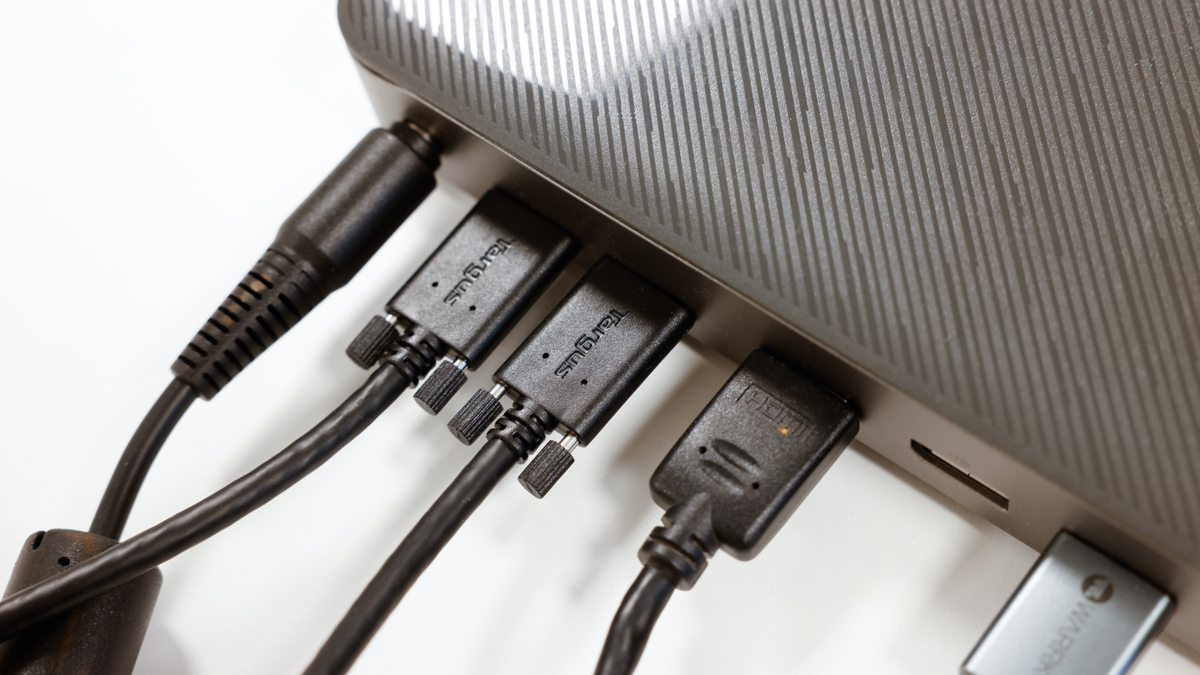
- Performance: 4 / 5
Targus Dual Host USB-C KVM 4K: Verdict
Priced at $499, this is a significant investment for any computer accessory, especially one that's neither a computer nor a hard drive. However, if you work with the best business monitors or the best business laptops, you'll appreciate the necessity of a KVM like this.
While there are features that could further enhance its usability, this KVM offers functionality that simplifies the process of using two machines. The auto-switching feature is one of the best workflow enhancements I have encountered.
It may be expensive, but for those using multiple machines, this device becomes indispensable. The speed of the switch is commendable, but it's the auto-switching and integration of machines and monitors that set the Targus Dual Host USB-C KVM 4K apart from other KVMs on the market. For this reason, in a professional environment, it justifies its price tag.
Value | Affordable, multifunctional solution for multi-device management needs. | 4 / 5 |
Design | Sleek, practical design; convenient for desktop placement. | 4 / 5 |
Features | Versatile connectivity, dual charging, supports multiple monitors. | 4 / 5 |
Performance | Reliable, efficient switching; enhances multi-device usability. | 4 / 5 |
Overall | An indispensable, versatile KVM for multi-device environments. | 4 / 5 |
Should you buy a Targus Dual Host USB-C KVM 4K?
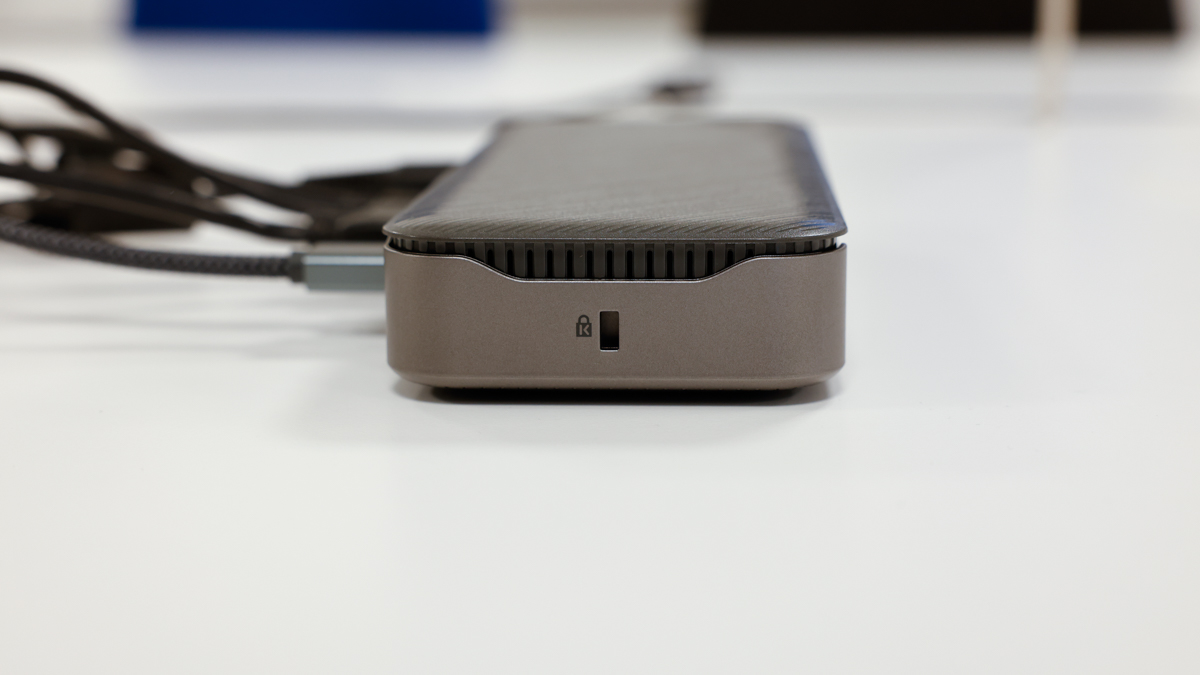
Buy it if...
Seamless Multi-Device Management
The Targus Dual Host USB-C KVM 4K excels in efficiently managing multiple devices. Its capability to seamlessly switch between two computers while sharing monitors and peripherals makes it an indispensable tool for multi-device environments.
Versatile Connectivity Options
Offering a wealth of connection possibilities, this KVM switch caters to various user needs. Its dual USB-C ports with full 100W power delivery, HDMI, and DisplayPort enable easy and flexible setups for diverse professional and personal uses.
Don't buy it if...
High-End Build Quality Seekers
If you prioritize premium build quality in your tech accessories, the Targus Dual Host USB-C KVM 4K, while functional, may not meet your expectations. Its construction lacks some of the high-end finishes that advanced users often seek.
Basic KVM Needs
For users who need a simple, straightforward KVM without the advanced features and configurations offered by this model, it might be more cost-effective to consider a more basic KVM switch that aligns better with simpler setup requirements.
How did I test
KVM switches range from simple to feature-packed, and the Targus Dual Host USB-C KVM 4K falls in the middle. It has enough features to satisfy most users, though it may lack the high-end build quality that advanced users expect. Nonetheless, in the studio and office, this KVM delivered what was required and more. During the test, these were a few of the aspects I focused on:
I work between a college and university centre and a photography studio, often switching between Mac and PC systems. While I mostly stick to one machine, there are times when I need to use both Mac and PC systems.
In this test, I first used the KVM with two MacBooks: a smaller MacBook Air M2 and a larger 16-inch M1. The larger machine is primarily used at home for more demanding tasks, while the impressively powerful Air is suitable for Photoshop work, writing, and general admin.
The other environment was in the studio, where some equipment requires a PC for software compatibility. This environment is usually a hassle, so integrating a KVM into the workflow was a good test of the Targus Dual Host USB-C KVM 4K's capabilities. The testing environments included:
Alastair is a photographer, filmmaker and tech writer who has been working in the publishing industry since the late 1990s. For more than 25 years he has covered photography, video and technology across Future's photography, technology and gaming brands. He runs a photography and video production company and lectures in TV and film. He can usually be found testing mini PCs or prototyping and prop building with the aid of 3D printing.
